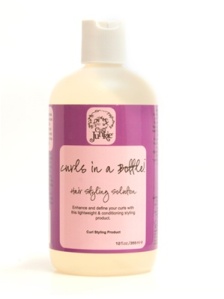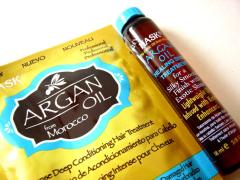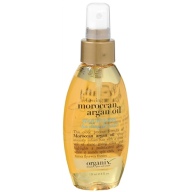Editor’s note: This is an unusual post for Curly Q&A, and it is one that I’ve spent considerable time contemplating. I aim to walk the thin line between helping men and women to accept their natural selves, and unwittingly convincing them that there is something wrong with them. My natural inclination is to do as little as possible to alter my appearance, while still appreciating it, which was the entire basis of this blog. Despite this, I’ve become increasingly aware of some major hair-related phobias streaming through the curly-headed minds of the strong women around me — the foremost being thinning hair. We’ve all heard about men’s hair loss, and it is much more socially acceptable — not completely of course, but more-so — than women’s hair thinning, and it’s generally equated with middle-age or older. The fact is that many of us will notice our hair thinning by our late 20’s to early 30’s. This can be a consequence of genes, stress, pregnancies, surgeries, and more.
The interview below was conducted with a young woman who noticed this happening on her own head in her mid-20’s, and she decided to do something about it. Below the interview you will also see a few tricks to help with the appearance of thinning hair. My advice is to fuss with your hair as little as possible, including coloring and straightening, and if you feel that thinning locks present a serious problem for you, it’s not unreasonable to seek the advice of a professional. Above all though, do not be ashamed — it’s absolutely, completely and totally normal!
———————————————————————————————-

For starters, become acquainted with your hair and how it grows.
Curly Q&A: First of all, thank you for granting me this sensitive interview. Would you mind telling me how old you are right now?
Jennifer: I am 31 years old.
CQA: When did you first notice that your hair might be thinning, and how did it make you feel?
J: In high school I had very thick hair that took forever to straighten. When I was 25 years old I began to notice that the shape of my hairline was changing — I was seeing a recession above my temples on both sides, as well as in the middle of my forehead. It became very noticeable to me when I straightened my hair that it was thinning.
CQA: What did you do to confirm whether your hair actually was thinning?
J: I decided to reach out to a male friend who worked at a hair restorative center to ask his opinion. He had gotten hair implants a few times, and offered to take a look for me. He said that my hairline looked normal to him, and that I should put it out of my mind, especially since stress actually will cause hair to fall out. I decided to stop thinking about it, and it didn’t really consume my thoughts again until 3-4 years later.
CQA: Why did it resurface?
J: It seemed to be getting worse, so I kind of freaked out and decided to see a dermatologist, which ended up being the best and the worst thing I had done up to that point for my hair. She was very cold to me, and when she delivered the news that her visual inspection caused concern, I broke down crying hysterically. The dermatologist went on to explain that the first step would be to do a blood test to see how my levels of iron, vitamin B6, and thyroid function were. She said that one possible solution, if I were lacking in any of these areas, would be to try adding more vitamins to my diet. If the blood tests came back normal, I could request a scalp biopsy to rule out alopecia.
CQA: What were the results?
J: My blood tests showed no vitamin deficiencies, but I still decided to supplement my diet with gelatin pills and more meat because I read that these things could help. I then requested the scalp biopsy so I could find out once and for all what was going on. The dermatologist harvested a small sample from my scalp, which (she claimed) “was the most obvious,” and took a patch of skin about 1″ in diameter. About 5 days later, she left a voicemail for me telling me that I do show signs of Androgenic Alopecia, the most common type of hair loss in women, which is a result of higher levels of a particular male hormone in the body. Immediately I broke down crying and shortly after I went into a depression. I spent all of my spare time researching female hair loss on the internet, and would even find myself staring at the scalps of other people to look at their follicles. I began to notice many women who also showed signs of hair loss and realized this was more common than I thought.
CQA: Did you have anyone to support you?

Before (left) and after (right) using Rogaine.
J: I called my male friend who had experience in this, and asked to speak with his doctor. I really did not connect with the dermatologist that I saw originally and wanted to talk to someone that I felt like I could trust, and who was on my side. I began seeing a trichologist who worked at a hair restoration center, and felt better immediately. He sat down and listened to me, and spoke to me about options. He also explained that the findings from my scalp biopsy was more a matter of opinion than fact since it’s not an exact science. There are parts of the scalp that will naturally exhibit smaller hair follicles, and that’s what they are looking for under the microscope to confirm you have alopecia. The main thing to consider was that if I did have alopecia, and any follicles closed up entirely, there is no way to re-open them. Through the use of topical medicines like Rogaine, though, hair follicles can be expanded to allow thicker strands to grow in, giving the appearance of more hair. I think that’s the biggest misconception about Rogaine; people think that it regrows hair, but it doesn’t. It helps you keep what you have and make the hair grow stronger and thicker. That’s why if you think you are definitely losing hair, it’s better to start using Rogaine sooner than later, because once the follicles close you can’t re-open them.
CQA: Interesting, I didn’t know that that’s how Rogaine works. Did you notice a difference?
J: I’ve been using it for 4 months, in addition to the gelatin pills and additional protein in my diet, and I have noticed an enormous difference. At first I was losing hair at a very alarming and very embarrassing rate, since Rogaine works by shedding thin hairs at first and then re-growing thicker ones. My friend doesn’t think that the Rogaine is the only thing to credit since it doesn’t usually work as quickly as it has for me. Reduced stress has probably played a large role.
CQA: How have you felt physically, with all of these changes?
J: The gelatin pills upset my stomach, so I cut back to one a day instead of two. I think I may have gained weight because of this as well, but I can’t be sure. The doctor assured me that there are no serious side effects of Rogaine, and told me that it was originally used in pill form as a heart medicine for women, so you may get lower blood pressure as a side effect, but they also noticed that women taking it were starting to grow facial hair! So, as I said before, it won’t create new hair follicles or re-open closed ones, but if you grow a little hair somewhere other than on top of your head, it will probably get thicker there. On the plus side, my eyebrows look great!
CQA: Wow, this has been such an educational conversation, I feel like I was with you through it all! Thank you so much. Are there any final words of warning or encouragement that you’d like to share?
J: Yes. I want to say that if any of this resonates with you, go ahead and do the tests and talk to doctors. And if it turns out that you do have alopecia, give yourself a few days to dwell on it. If it’s upsetting, let yourself feel upset. But then, after a few days or a week, STOP. I was finding myself becoming obsessed, staring at random people on my commute and in meetings at work — it was too much! It turns into a type of madness. The doctor’s last words of advice were to stop stressing out, because that was going to counter any steps we were taking to remedy my hair loss. I gave myself 5 months to try all of the things I mentioned: diet, vitamins, and Rogaine; and promised that I wouldn’t think any more about it during that time. It’s been 4 months and I’ve made such amazing strides! I’ve even been getting compliments on how full my hair looks. If I stop using the Rogaine I’d likely go back to the same problem as before, but I will re-visit that when I need to. In the meantime, it just feels like a huge weight has been lifted.
* Participant’s name has been altered to protect her identity.
Tricky Tips for Fuller-Looking Hair
As promised, here are some quick tips if you feel like your hair is thinner than it used to be, but like me, are not worried about long-term effects. It helps to look at your mother’s and father’s hair and to compare notes. My mother’s hair thinned in the same areas as mine has at 30 years old, but it hasn’t gotten any worse, so I’m not worried. If I ever feel like I should be concerned, though, I won’t hesitate to visit a specialist!
1) Put a dime-sized dab of conditioner on the tips of your fingers and massage it into your scalp. Use more if scalp feels especially dry. This will “fill out” the area between follicles a bit more, and ruffling the cuticles at the roots will make them look more voluminous as well. It’s also good scalp care.
2) Spray or sprinkle some dry shampoo on your scalp, only at the roots. Let it sit for a few seconds, and then ruffle hair at the roots. Do not rustle or apply to the middle or ends of hair strands.
3) Supplement buns with those silly donut things, they are easy to use and really work!

4) Pin bangs to the side. This works best if you have shorter layers in front, but it can also work with longer hair. Instead of pulling all hair straight back into a pony or bun, take an inch-wide section of hair and bobby pin it to the side along your hairline with the least amount of coverage. Take the rest of the hair and put it up as usual.
5) Accept it! If it’s not causing any problems and you’ve never noticed hair loss before this post, guess what? You’re normal. If you have noticed it before and are getting worried, guess what? You’re also normal! We all have different genetic make-up and we’ve won a genetic lottery of sorts by getting a chance to live life at all. Focus on what matters most, and don’t stress the rest!
 I’m so excited to announce a new product that I’ve tested and absolutely love! As you may remember, it’s important to rotate all of the products you use, which are basic non-damaging cleansers (WEN conditioning cleansers, DevaCurl No Poo, DevaCurl Low Poo, lemon juice and conditioner equal-parts mixtures), conditioners (DevaCurl One Condition, Ouidad Curl Quencher Conditioner, Argan Oil conditioners, Avalon Organics Volumizing Rosemary conditioner, Aussie Moist conditioner, etc. etc. etc. and yes I have all of these and more in my shower right now), and styling products. We’ve discussed cremes, gels, mousses (meese?), you name it. I’ve found that a light gel works best for my hair type. Until now I’ve mainly been using DevaCurl’s Angel and Ouidad’s Climate Control gel because both are light hold.
I’m so excited to announce a new product that I’ve tested and absolutely love! As you may remember, it’s important to rotate all of the products you use, which are basic non-damaging cleansers (WEN conditioning cleansers, DevaCurl No Poo, DevaCurl Low Poo, lemon juice and conditioner equal-parts mixtures), conditioners (DevaCurl One Condition, Ouidad Curl Quencher Conditioner, Argan Oil conditioners, Avalon Organics Volumizing Rosemary conditioner, Aussie Moist conditioner, etc. etc. etc. and yes I have all of these and more in my shower right now), and styling products. We’ve discussed cremes, gels, mousses (meese?), you name it. I’ve found that a light gel works best for my hair type. Until now I’ve mainly been using DevaCurl’s Angel and Ouidad’s Climate Control gel because both are light hold. HOWEVER! My hair has been looking stringy and angry lately, despite oil treatments and my tender lovin’ care. I saw a brand I’d never seen before when researching my hair type on Naturallycurly.com. [Btw people — check them out! You take a quiz to determine your curl/hair type, and then you can read all about other members who have your hair type and what products they use, how they style it, and much more. It’s like a Pinterest board of curly hair care. My type is 3a, and they corroborated my findings that a light hold gel is my hair’s bff].
HOWEVER! My hair has been looking stringy and angry lately, despite oil treatments and my tender lovin’ care. I saw a brand I’d never seen before when researching my hair type on Naturallycurly.com. [Btw people — check them out! You take a quiz to determine your curl/hair type, and then you can read all about other members who have your hair type and what products they use, how they style it, and much more. It’s like a Pinterest board of curly hair care. My type is 3a, and they corroborated my findings that a light hold gel is my hair’s bff].























